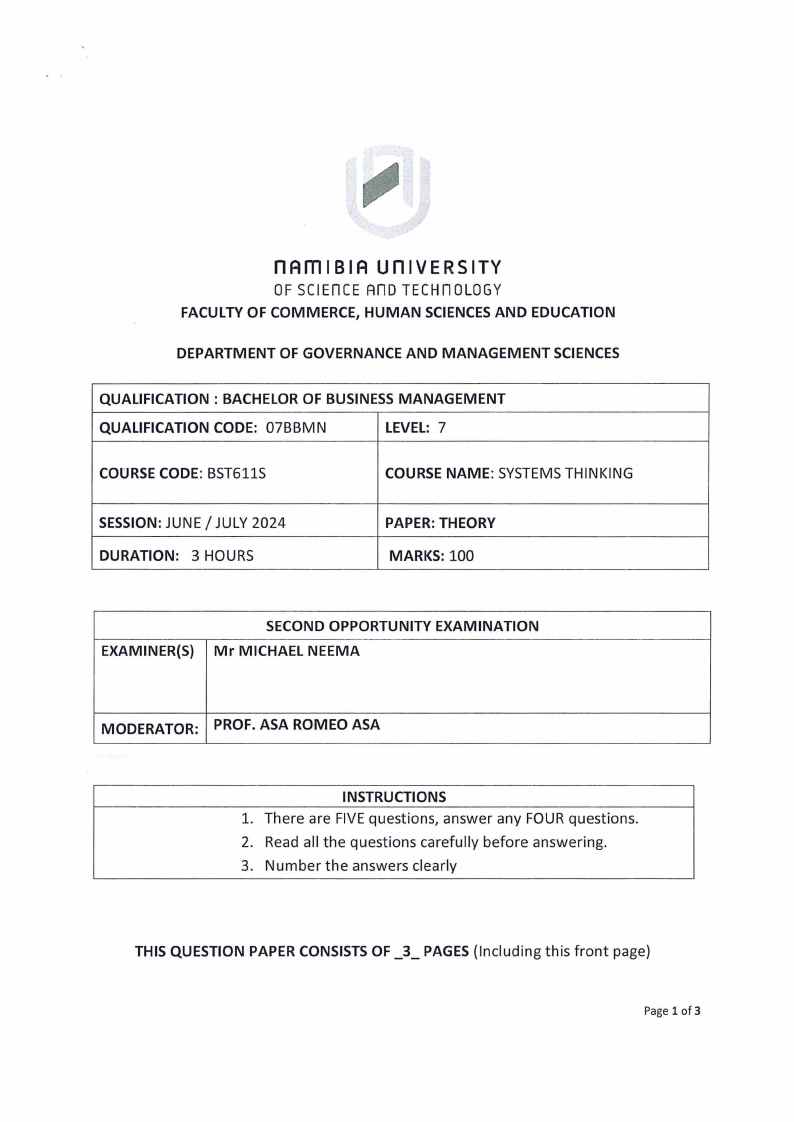 |
BST61S - SYSTEM THINKING - 2ND OPP - JUNE 2024 |
 |
1 Page 1 |
▲back to top |

nAmlBIA unlVERSITY
OF SCI En CE Ano TECH n OLOGY
FACULTY OF COMMERCE, HUMAN SCIENCESAND EDUCATION
DEPARTMENT OF GOVERNANCE AND MANAGEMENT SCIENCES
QUALIFICATION: BACHELOR OF BUSINESS MANAGEMENT
QUALIFICATION CODE: 07BBMN
LEVEL: 7
COURSE CODE: BST611S
COURSE NAME: SYSTEMSTHINKING
SESSION: JUNE/ JULY 2024
DURATION: 3 HOURS
PAPER: THEORY
MARKS: 100
EXAMINER(S)
SECOND OPPORTUNITY EXAMINATION
Mr MICHAEL NEEMA
MODERATOR: PROF. ASA ROMEO ASA
INSTRUCTIONS
1. There are FIVE questions, answer any FOUR questions.
2. Read all the questions carefully before answering.
3. Number the answers clearly
THIS QUESTION PAPER CONSISTS OF _3_ PAGES (Including this front page)
Page 1 of 3
 |
2 Page 2 |
▲back to top |

Question 1
a) Read the following statements and indicate whether each statement is
"True" or "False". (2 marks each)
(20 marks)
i. The systems components can be tangible components or intangible
components.
ii. An organization is an example of a system, this is so because it is composed
of interconnected parts.
iii. Systems thinking focuses on understanding the complex relationships
between different elements of an organization, such as its people,
processes, and technology, and how they affect each other.
iv. "The easy way out usually leads back in" is one of the 11 laws of systems
thinking.
v. The order in which the systems parts are arranged does not affect the
performance of a system.
vi. General systems theory proposes that the structure of any system is often
as important in determining its behaviour.
vii. General systems theory proposes that irrespective of their purposes/field,
complex systems do not share several basic organizing principles.
viii. Events, patterns, systemic structures and mental models are generally true
components of systems.
ix. In general, ANALYSIS is defined as the procedure by which we combine
separate elements or components in order to form a coherent whole.
x. · Systems thinking can also be referred to as narrow thinking and not
necessarily big picture thinking.
b) Demonstrate how Systems thinking is useful towards organizational
effectiveness?
(5 marks)
Page2 of 3
 |
3 Page 3 |
▲back to top |

Question 2
a) Define the concept "systems archetype"? In your answer, indicate why
systems archetypes are important tool of systems thinking. (10 marks)
b) One of the ten (10) systems archetypes is the 'Tragedy of the Commons'.
With reference to specific examples, demonstrate your understanding of this
systems archetype and suggest at least five ways through which problems
arising from it may be managed.
(15 marks)
Question 3
a) According to Peter Senge, a learning organisation structure is comprised of
the five principles. Demonstrate your understanding of these five principles
and indicate how they are related to each other.
(25 marks)
Question 4
a) Define the concept "Organizational Sustainability".
(5 marks)
b) Using your own examples, describe the 'Triple Bottom Line' concept and
outline ways how it can contribute to the sustainability of organizations.
(20 marks)
Question 5
a) With the aid of an appropriate example, demonstrate how the principles of
the "u-theory" can be used to solve a complex issue.
(25 marks)
The end
Page3 of 3





